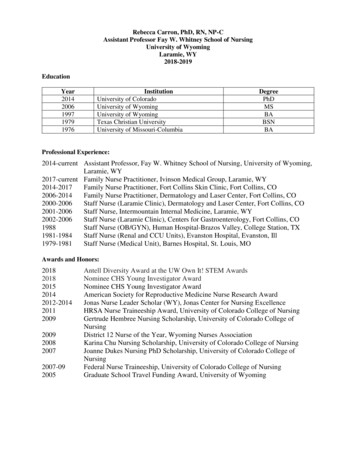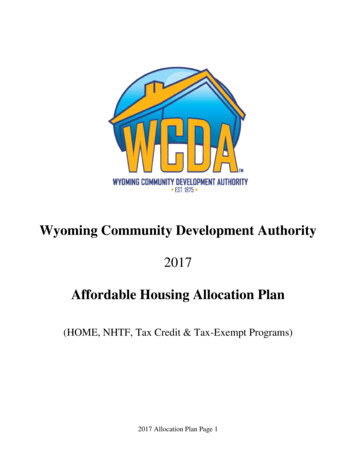
Transcription
Wyoming Community Development Authority2017Affordable Housing Allocation Plan(HOME, NHTF, Tax Credit & Tax-Exempt Programs)2017 Allocation Plan Page 1
Wyoming Community Development AuthorityALLOCATION PLAN INDEXPage4-5I. OverviewII. Application Process6-10III. Set-Asides11-14IV. Initial Allocation Process15-16V. Initial Allocation Criteria17-33VI. Maximum Allocations34-35VII. Program RequirementsAll ProjectsRental ProjectsHOME ProgramHOME Rental ProjectsTax Credit Projects36-3839-4142-4344-4546-48VIII. Tax CreditAllocationProgramEvaluationandIX. Tax Credit Assistance Program (TCAP)X. Compliance Monitoring495051-59XI. Disclaimer602017 Allocation Plan Page 2
Wyoming Community Development AuthorityCURRENT YEAR SUMMARY 1617626262636363646464656565656767686869Third Party InformationMarket Study Recap for Rental ProjectsContractor’s CertificateArchitect's Certificate123707374Published NumbersIncome and Rent Limits177Other RequirementsNarrative RequirementsQuarterly Progress Reports for Rental Projects127881Miscellaneous InformationInitial Allocation CyclesAnticipated HOME FundingTax Credit AvailabilityNeighborhood Stabilization Program (NSP) FundingTax Credit Assistance Program (TCAP) FundingNational Housing Trust FundTotal per unit Project Cost for Rental projectsOperating Expenses LimitationsMaximum HOME/NHTF Subsidy per unitMaximum HOME Homeownership Value LimitsHOME Match RequirementsProperty Development StandardsMarket Study RequirementsTax Credit - Total Per unit Eligible BasisSyndication Tolerance LevelQualified Census Tracts (QCT) &Difficult Development Areas (DDA)Priority Target PopulationsEHOME Program Description82FOther Federal Requirements107GNSP (1) Program Description123HNSP3 Program Description131INational Housing Trust Funds Program Description1322017 Allocation Plan Page 3
Wyoming Community Development AuthorityI. OverviewI. OVERVIEWThis Allocation Plan was designed to select those developments which satisfy the most pressing housing needs ofthe State, within the guidelines established by Section 42 (m)(1)(B) of the Internal Revenue Code, under HUD'sHOME Investment Partnerships Program at 24 CFR Part 92, and under HUD’s National Housing Trust Fund(NHTF) program at 24 CFR Part 93. The four most significant criterions for Tax Credit, HOME, and NHTFapproval are: Need,Quality of construction,The characteristics of the households being served, andAffordabilityThe Low-Income Housing Tax Credit was created by the Tax Reform Act of 1986 to encourage the constructionand rehabilitation of housing for very low, low, and moderate-income individuals and families. Congress mandatedthat housing credit agencies adopt an "Allocation Plan" which defines the process used to distribute the Creditamong projects.The Tax Credit Program is a regulated and highly complicated program. Final interpretations of certain rules andregulations governing various facets of the program have not yet been issued by the U.S. Department of Treasury;consequently, additional requirements or conditions applying to the tax credit may be forthcoming.The total amount of Tax Credits available in Wyoming is disclosed in the Current Year Summary Attachment “A”.The HOME Investment Partnership Program (HOME) was created under Title II (the Home InvestmentPartnerships Act) of the National Affordable Housing Act of 1990. The HOME Final Rule is codified under 24 CFRPart 92 (HOME Investment Partnerships Program). The general purposes of HOME include: 1.) the expansion ofthe supply of decent and affordable housing, particularly rental housing, for low and very-low-income Americans,2.) strengthening the abilities of State and local governments to design and implement strategies for achievingadequate supplies of decent, affordable housing, and 3.) extending and strengthening partnerships among all levelsof government and the private sector, including for-profit and non-profit organizations, in the production andoperation of affordable housing.The National Housing Trust Fund was established under Title I of the Housing and Economic Recovery Act of2008, Section 1131 (Public Law 110-289). Section 1131 of HERA amended the Federal Housing EnterprisesFinancial Safety and Soundness Act of 1992 (12 U.S.C. 4501 et seq.) (Act) to add a new section 1337, entitled"Affordable Housing Allocation" and a new section 1338, entitled "Housing Trust Fund." The program is codifiedunder 24 CFR Part 93. NHTF is an affordable housing production program that will complement existing Federal,State, and local efforts to increase and preserve the supply of decent, safe, and sanitary affordable housing forextremely low-income (ELI) and very low-income households (VLI), including homeless families.It is strongly suggested that project sponsors interested in the Tax Credit Program, the HOME program,and/or the NHTF program contact their tax accountant and/or attorney before developing projects under2017 Allocation Plan Page 4
Wyoming Community Development AuthorityI. Overviewany of these programs. While WCDA will endeavor to assist applicants, WCDA personnel are not tax or legalexperts and applicants should not rely on WCDA personnel for tax and/or legal advice.The Consolidated Plans for Housing and Community Development for the City of Casper, the City of Cheyenne,and the State of Wyoming ("Consolidated Plans") identify several priorities for housing. This Affordable HousingAllocation Plan is designed to allocate funding based on these priorities to the citizens of Wyoming. Those applyingfor funding under HOME, NHTF, and/or Tax Credits must consider how their project addresses the needs for theState of Wyoming. See Item 17 in the Current Year Summary, Attachment “A”.All recipients of Tax Credit, HOME and/or NHTF funding must meet the following definition:Recipient means an organization, agency, or other entity (including a public housing agency, or a for-profit entityor a nonprofit entity) that receives Tax Credit, HOME and/or HTF assistance from a grantee as an owner ordeveloper to carry out a Tax Credit, HOME and/or HTF-assisted project. A recipient must:1. Make acceptable assurances to the grantee that it will comply with the requirements of the Tax Credit,HOME and/or HTF program during the entire period that begins upon selection of the recipient to receivefunds, and ending upon the conclusion of all funded activities;2. Demonstrate the ability and financial capacity to undertake, comply, and manage the eligible activity;3. Demonstrate its familiarity with the requirements of other Federal, State, or local housing programs thatmay be used in conjunction with Tax Credit, HOME and/or HTF funds to ensure compliance with allapplicable requirements and regulations of such programs; and4. Have demonstrated experience and capacity to conduct an eligible activity as evidenced by its ability to:a. Own, construct, or rehabilitate, and manage and operate an affordable multifamily rental housingdevelopment ORb. Design, construct, or rehabilitate, and market affordable housing for homeownership; andc. Provide forms of assistance, such as down payments, closing costs, or interest rate reductions forpurchasers.In the event there are changes in federal law subsequent to the adoption of this Allocation Plan or additionalregulatory guidance or clarifications regarding the Tax Credit Program, the HOME Investment PartnershipsProgram, and/or the National Housing Trust Fund Program becomes available, the Authority may modify,supplement or make conforming amendments to this Allocation Plan and all related documents without formalamendment or additional public hearings. WCDA will notify applicants affected by these changes and in addition,information about such subsequent changes will be posted on the Authority’s website at www.wyomingcda.com.2017 Allocation Plan Page 5
Wyoming Community Development AuthorityII. Application ProcessII. APPLICATION PROCESSThe WCDA utilizes a single application for all Tax Credit Program, HOME, and NHTF funding. Availablefunding levels and allocations are outlined in the Allocation Plan Current Year Summary Attachment “A”. Inaddition, specific set-asides and their eligibility criteria are outlined in Section III of this document. Please notethat if the WCDA deems additional cycles as necessary to obligate funds in a timely manner, WCDA may conductadditional application cycles within the current funding year.ALL projects applying for Tax Credits or Tax Exempt Bond Financing must comply with all aspects of theWyoming Community Development Authority Affordable Housing Allocation Plan (Allocation Plan). Thisincludes, but is not limited to, those projects applying for credits under the state Tax Credit Cap, and those projectsapplying for credits when utilizing Tax-Exempt Bond financing, whether or not WCDA is the Bond Issuer.ALL projects applying for HOME funds must comply with all pertinent aspects of the Wyoming CommunityDevelopment Authority Affordable Housing Allocation Plan (Allocation Plan). This includes compliance with24 CFR Part 92 as detailed in the WCDA HOME Program Description (Allocation Plan Current Year SummaryAttachment “E”). The Developer will certify that housing assisted with HOME funds will comply with all HOMErequirements.ALL projects applying for NHTF funds must comply with all pertinent aspects of the Wyoming CommunityDevelopment Authority Affordable Housing Allocation Plan (Allocation Plan). This includes compliance with24 CFR Part 93 as detailed in the WCDA NHTF Program Description (Allocation Plan Current Year SummaryAttachment “I”). The Developer will certify that housing assisted with NHTF funds will comply with all NHTFrequirements.All projects receiving HOME funds, NHTF funds, and/or an allocation of Section 42 Tax Credits will beresponsible for indemnifying WCDA in the event HUD and/or Treasury enforce any type of recapture or otherpenalties on the project.The application fee for Tax Credits is 500 for projects with twenty four units or less and 1,500 for projects withover twenty four units. This fee must be included with the application. Applications received without this fee maybe returned. The application fees may be subject to change at a later date. There are no application fees for projectswhich are applying for HOME and/or NHTF funds.Those applying for funding under any of these programs need to submit:1. Completed original signed physical copy of the WCDA 2017 Affordable Housing Programs Application(Application), including all supplements and appropriate Exhibits (The most current application must beused; no substitutions or changes to any forms will be accepted);2. Electronic version of the Application in Microsoft Excel format via your preferred media format (CD orUSB drive). Make sure it is not locked or a shared file;3. Affirmative Fair Housing Marketing Agreement (Application Exhibit A-1);4. Development Team Experience (Application Exhibit A-2);5. Previous Participation Statement and Authorization for Release of Information (Application Exhibit A-3);6. HUD Environmental Checklist (Application Exhibit A-4);7. WCDA Non-Profit Participation Questionnaire, if applicable (Application Exhibit A-5);2017 Allocation Plan Page 6
Wyoming Community Development AuthorityII. Application Process8. WCDA Application for Community Housing Development Organization (CHDO) Status Under the HOMEInvestment Partnership Program (HOME) as stated in 24 CFR Part 92, if applicable (Application Exhibit A6);9. 15 year Projected Cash Flow;10. Utility Allowances;11. Independent comprehensive, timely, and professional Market Study. At a minimum, the Market Study mustinclude those items outlined in the Current Year Summary Attachment “A” Item “13” and the Market StudyRecap located in the Current Year Summary Attachment “B” Item “1”. If the Market Study contradictscurrent economic statistics on file with WCDA, the project may not rank in the needs category. A MarketStudy will be accepted by WCDA if it meets the required elements as listed in the Allocation Plan CurrentYear Summary Attachment “A” Item “13”, and includes a completed Market Study Recap sheet found inthe Allocation Plan Current Year Summary Attachment “B” Item “1”;NOTE: WCDA does not approve individual market study providers. Each Developer/Owner isresponsible for providing a market study which accurately reflects the information necessary forWCDA to evaluate the current and future need for the project being proposed.12. Current letter of consistency with the Consolidated Plan from the appropriate jurisdiction if the project islocated in an entitlement city (required on all projects requesting HOME funding);13. Documentation showing the local jurisdiction has been notified and given specific information regardingthe project;14. Site Control documentation;15. Documentation of proper zoning;16. Flood Plain Documentation;17. Estimated tax expense from County Assessor (or current assessment for Rehabilitation projects);18. Location Map showing location of the site relative to the surrounding neighborhood;19. City Map showing location of the site;20. Map showing zoning of the site and adjacent areas;21. Sketch plan of the site (3-dimensional if possible);22. Floor plans;23. Capital Needs Assessments including an Economic Feasibility Assessment of Expenses, stating the viabilityand long-term feasibility of the project (required on all rental rehabilitation projects);24. All Acquisition/Rental Rehabilitation project must provide a timely appraisal by an independent 3rd party(generally appraisals are considered timely if less than 6 months old – the acquisition price on which taxcredits are allocated will be limited to the lesser of the sales price or the appraised value of the property priorto rehabilitation);25. Itemized list, by unit, of rehabilitation activities and costs;26. Projects built in phases are to complete the application reflecting information on the current phase, andexplain each phase and the entire project in the narrative;27. Narrative Description of Project (Allocation Plan Current Year Summary, Attachment “D” Item “1”);28. Detailed written explanation of how and why the applicant feels the scoring criteria has been met;29. Appropriate Application Fee;30. Copy of Deed showing ownership changes proving 10-year rule requirements (forAcquisition/Rehabilitation projects with Tax Credits);31. Developer Fee Agreement;32. Current documentation from the local jurisdiction that the project is in a Community Revitalization Plan(CRP) area (if applicable);33. Certification of Compliance Training;2017 Allocation Plan Page 7
Wyoming Community Development AuthorityII. Application Process34. Financial Statements of Owner, Developer, General Partner and all Guarantors;35. Owners and Developers applying for federal funding for all Occupied Acquisition/Rehabilitation projectsmust provide every tenant with a General Information Notice (GIN) per HUD requirements prior to theapplication being submitted. A copy of the GIN and proof of delivery must accompany the application;36. Projects with occupied units are eligible for HOME or NHTF funding, however the Developer must addressall requirements under Attachment “F”, Other Federal Requirements, Section 92.353 Displacement,Relocation and Acquisition;37. All Tax Credit projects must provide a Letter of Intent from a minimum of one syndicator which mustinclude an anticipated date of when a firm commitment will be issued;38. All projects requesting credits that exceed the Total per unit Eligible Basis published by WCDA in theCurrent Year Summary Attachment “A”, must include documentation satisfactory to WCDA, justifying thehigher costs, and thus the higher Eligible Basis. [E.g. Three or more bids for construction items, current RealEstate listings for like properties in the area (to help justify land cost), costs to address seismic or otherunique building requirements, impact on the community, etc.]; and39. Determination letter from the State Historic Preservation Office (SHPO), clearing the site for improvementsor necessary mitigation requirements.Tax Credit Initial Allocations, HOME, and/or NHTF funded Initial Allocations are NOT transferable. Once anInitial Allocation is granted, the project may not be changed in any way without WCDA's prior written consent. Inaddition, prior to application, it is highly recommended the owner verify the name they intend to use is available byobtaining a Certificate of Good Standing from the State.Scattered Site projects are acceptable under this plan only if all units are covered under the same financing, andare located within the same city, or if none of the individual sites are within city limits, within the same countyHowever, the Primary Market Area defined in the Market Study must make sense. To receive the 130% increasein basis allowed under Section 42 the entire project must also be located within a Qualified Census Tract orDifficult Development Area. While separate applications are required for projects located in different cities,projects may be bundled for outside financing and syndication purposes.All housing that is constructed or rehabilitated must meet all applicable local codes, rehabilitation standards,ordinances, and zoning ordinances at the time of project completion. In absence of a local code new construction orrehabilitation must meet, as applicable, the International Building Code (as applicable to the type of housing) of theInternational Code Council.Newly constructed housing using HOME funding must also meet the requirements of 24 CFR Part 92.251(a)(2)(i)through (V).Newly constructed housing using NHTF funding must meet requirements of 24 CFR Part 93.301(a).All projects must be located on a site eligible for federal financial assistance. The types of items that are reviewedwhen looking at a site are listed below: The site's proximity to noise sources such as railroads, highways or busy streets, and airports or militaryairfields. The site and the project must have a clearance from the state historic preservation office.2017 Allocation Plan Page 8
Wyoming Community Development AuthorityII. Application Process The site cannot be in a 100-year flood plain. Lead-based paint and asbestos are concerns and must be dealt with in accordance with HUD and state requirements.The site's proximity (within 3,000 feet) to a hazardous waste siteThe site’s proximity to above ground or underground storage tanks containing hazardous materials.Concentration of low income housing (Environmental Justice)Zoning and uses of land surrounding the siteProximity to ServicesWCDA will also do a site visit to determine the site's suitability for the type of housing being proposed. All HOMEfunded projects will have to meet HUD's environmental review process and HUD’s site and neighborhood standardsrequirement at 24 CFR Part 92.202. All NHTF funded projects will have to meet HUD's environmental reviewprocess and HUD’s site and neighborhood standards requirement at 24 CFR Part 93.150. Site selection is extremelyimportant and is part of the evaluation and ranking process.Applicants must be current on all fees due and owing WCDA before an application will be accepted. An applicationmay be denied if it is determined that the developer or other key participants have other projects that are notprogressing or have not progressed as scheduled in the Development Timetable within WCDA’s Application and/orAgreement. The Development Timetable will be proposed by the Developer and must be approved by WCDA foreach Application and/or Agreement (See Column 2 “Application Planned Timetable” of Attachment “D”).Incomplete applications may be returned. Applications once submitted are considered final and may not be revised.WCDA has the right not to fund a draw or issue IRS form(s) 8609 if the project is not progressing or has not beencompleted according to the original application. However, WCDA may ask for additional information and updatesas needed.WCDA reserves the right to reject an application, or assess negative points, if the Owner, Management Company,or any material participant has outstanding non-compliance issues, or if an applicant, material participant ormanagement company has a history of poor performance under any program administered by WCDA, or undercomparable programs in other states or jurisdictions.Projects requesting tax credits from the non-profit set-aside need to submit a Non-Profit Certification (SeeApplication Exhibit A-6) as to the non-profit's involvement in the project. This certification must be submitted withthe application and updated annually throughout the compliance period.Wyoming has not set specific geographic areas in which assistance will be directed over the coming year.However, as more and more affordable housing units are developed, it is becoming increasingly more importantto target these funds to the areas of the greatest need. Applicants for funding will need to show that there is ademand for the type and price of unit they are proposing. WCDA will be utilizing the Wyoming Housing DatabasePartnership Reports (Semiannual Profiles, Housing Conditions Report & Forecasts) for comparison to theDevelopers own information. While the WCDA continues to recognize need as the primary driver of housingwithin any given community and maintains scoring that reflects this principle, a scoring category for geographicdistribution is included in the allocation plan. This category will help ensure that affordable housing resourcesare distributed throughout the state and no one community shall benefit disproportionately to the rest of the state.The WCDA provides a list of funded projects by community on its web-site for its housing programs.2017 Allocation Plan Page 9
Wyoming Community Development AuthorityII. Application ProcessDevelopments which need additional Tax Credits, HOME, and/or NHTF funding to be viable must submit a newApplication for funding with the Authority during a normal funding round. Said applications will not beconsidered for substitution of Tax Credits if their Application has substantially changed. In order to receiveadditional funding the project must successfully compete against other projects in that round. Further, theAuthority may not consider any other Applications for Tax Credits, in its sole discretion, for a new developmentsubmitted by the same applicant (or related entity or material participant) during the same or following fundinground for Tax Credits if it provides this extraordinary relief due to the Developer's inability to complete theproject.Notwithstanding anything herein to the contrary, the Authority may, in its sole discretion and in accordance withany such additional guidance or regulatory direction implementing amendments to Section 42 of the Code, 24CFR Part 92, and/or 24 CFR Part 93 establish alternative, supplemental, or additional processing requirementsand deadlines. Any such changes or supplements shall be effective upon written instruction by the Authority tothe affected developments.Applications and other supporting documentation should be mailed or delivered to by the date and time indicatedin Current Year Summary, Attachment “A”:WCDAAttn: Federal Programs155 North Beech (82601)P.O. Box 634 (82602)Casper, WY2017 Allocation Plan Page 10
Wyoming Community Development AuthorityIII. Set-AsidesIII. SET-ASIDESTax Credit ProgramNon-Profit Set-asideTen percent (10%) of the total annual credit available is required to be set aside for projects in which 501(c)(3) or501(c)(4) non-profit organizations materially participate in the development and management of the project.In the event there are insufficient tax credits available to fully fund all projects that meet minimum scoringthresholds, the respective set-aside categories shall be funded in the following order of priority: 1.) Non-Profits;2.) Small Rural Projects; 3.) Open Allocation.In the event that funds in the Non-Profit Set-Aside have been exhausted, unfunded applications meeting theminimum scoring threshold will compete in the Open Allocation category. In the event that funds in the SmallRural Set-Aside have been exhausted, unfunded applications meeting the minimum scoring threshold will be fundedby a reallocation from the Open Allocation category.See Current Year Summary Attachment “A”.Small Rural Project Set-asideSmall projects in rural areas are extremely difficult to develop. As such, a set-aside has been created for small ruralprojects allowing these projects to compete on a more even level. The amount of the set-aside is disclosed in theCurrent Year Summary Attachment “A”.In order to qualify for the Small Rural Project Set-aside the following criteria applies: The project must be in a small community with a population under 15,000 and no communities with apopulation over 15,000 are within 20 miles of the project. The project must have 24 or fewer units The project must not be done in conjunction with a separate project in the same locale.Due to the fact that Market Rents are typically lower than Tax Credit Rents in Rural areas, projects may have a 10%variance in Income and Rent levels when qualifying for the Small Rural Project Set-aside.Other financing partners in small and/or rural projects typically require higher Reserve Accounts. WCDA in its solediscretion may remove these costs when analyzing the total projects costs for scoring purposes.Projects of 12 units or less that qualify under the Small Rural Project Set-aside will be allowed to earn a DeveloperFee up to 500,000 per project. Developer fees for projects of 13 to 24 units will be calculated per normal WCDAguidelines.2017 Allocation Plan Page 11
Wyoming Community Development AuthorityIII. Set-AsidesHOME ProgramOpen CategoryThe approximate amount of funding set-aside in this category for Rental Housing Production programs is outlinedin the Current Year Summary, Attachment “A”. These funds will be distributed through a competitive applicationprocess. If through this process, not all of the funds are allocated in the specified funding cycles, WCDA will allocatethem to eligible projects through a second competitive application process or to projects meeting the minimumranking criteria on a first-come, first-served basis as determined by WCDA in its sole discretion.HOME/WRAPThe approximate amount of funding set-aside in this category for HOME/WRAP programs is outlined in the CurrentYear Summary, Attachment “A”. These funds will be administered by WCDA similar to the WRAP programcreated under the Neighborhood Stabilization Program. If all the HOME funds are not allocated in the first fundingcycle, WCDA may retain any funds under any of the set asides for this eligible activity. In addition, as Programincome is received and the available funding is increased, such funds may also be used under this set-aside.Community Housing Development Organizations (CHDO)Fifteen percent (15%) of the Fiscal Year HOME funding allocation will be set aside for CHDO's. Applications willbe accepted from certified CHDO’s for CHDO eligible activities through a competitive application process. Ifthrough this process, not all of the funds are allocated in the specified funding cycles, WCDA will allocate the fundsto eligible projects through a second competitive application process or to projects meeting the minimum rankingcriteria on a first-come, first-served basis as determined by WCDA in its sole discretion. Ten percent of this setaside may be available for which CHDOs may apply for Project Specific Technical Assistance and Site ControlLoans.CHDO General Operating costs and Capacity Building ReserveApproximate funding as disclosed in the Current Year Summary Attachment “A” will be set-aside in thiscategory. CHDO’s may apply to WCDA on an annual basis, prior to September 1st of each year, for OperatingCosts and/or Capacity building funds.Small Rural Project Set-AsideIn recent years it has been evident that the small communities have been overlooked on their affordable housingneeds. In order to create an incentive for developers to consider more rural areas, and satisfy HUD’s geographicdistribution requisite, this Small Project Set-Aside was created. The amount of the set-aside is disclosed in theCurrent Year Summary Attachment “A”.In order to qualify for the Small Rural Project Set-aside the following criteria applies:1. The project must be in a small community with a population under 15,000 and no communities with apopulation over 15,000 are within 20 miles of the project.2. The project must have 24 or fewer units2017 Allocation Plan Page 12
Wyoming Community Development AuthorityIII. Set-Asides3. Project must not be done in conjunction with a separate project in the same locale.Due to the fact that Market Rents are typically lower in rural areas, projects may have a 10% variance in Incomeand Rent Levels when qualifying for the Small Rural Project Set-aside.Administration and Contingency ReserveApproximately 10% of the HOME funding allocation will be set aside for this account. WCDA Administrativecosts, and a reserve for project over-runs that cannot be met from other funding sources, are all authorized usesfor this set-aside.If it appears that not all funds under any set-aside will be committed or utilized, the funding may revert to otherset-asides as determined by WCDA.NHTF ProgramRental Production and RehabilitationThe approximate amount of funding set-aside in this category for Rental Housing Production programs is outlinedin the Current Year Summary, Attachment “A”. These funds will be distributed through a competitive applicationprocess. If through this process, not all of the funds are allocated in the specified funding cycles, WCDA will allocatethem to eligible projects through a second competitive application process or to projects meeting the minimumranking criteria on a first
The Consolidated Plans for Housing and Community Development for the City of Casper, the City of Cheyenne, and the State of Wyoming ("Consolidated Plans") identify several priorities for housing. This Affordable Housing . WCDA Non-Profit Participation Questionnaire, if applicable (Application Exhibit A-5); Wyoming Community Development Authority
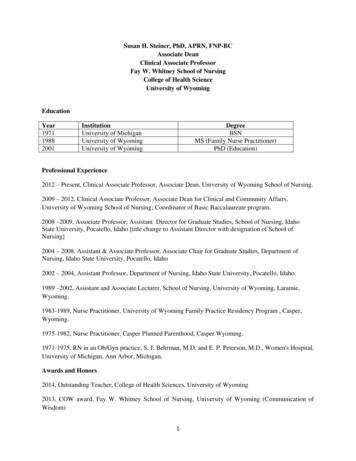
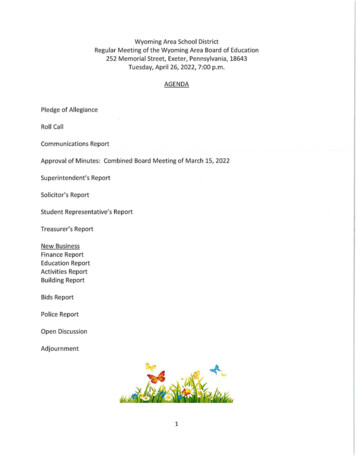


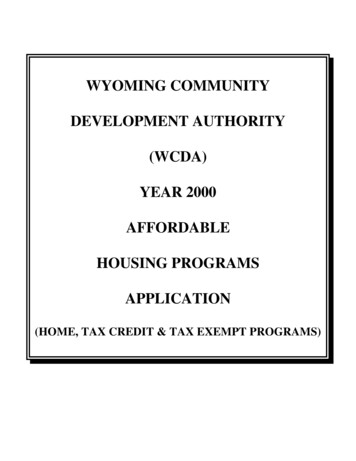
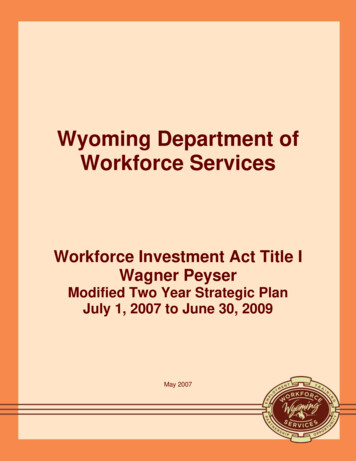

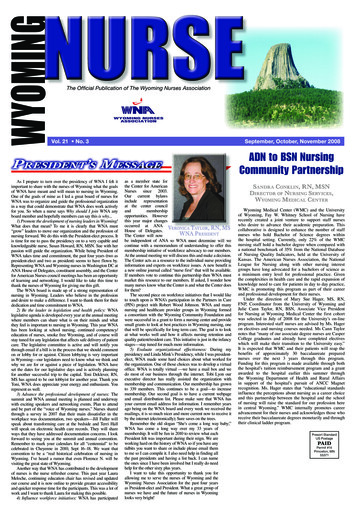
![Welcome [ wyomingworkforce ]](/img/14/program.jpg)
